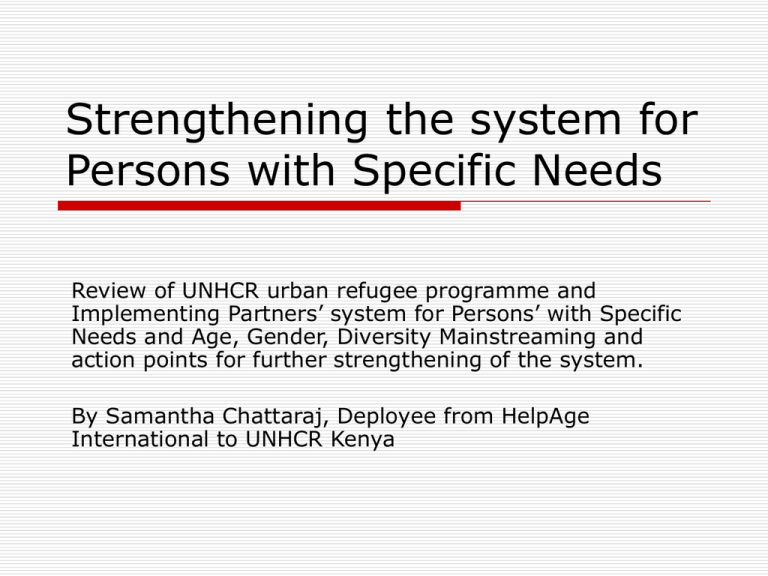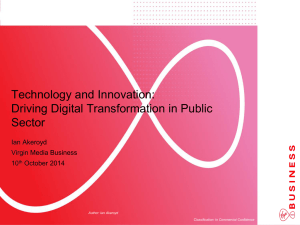Strengthening the system for Persons with Specific Needs
advertisement

Strengthening the system for Persons with Specific Needs Review of UNHCR urban refugee programme and Implementing Partners’ system for Persons’ with Specific Needs and Age, Gender, Diversity Mainstreaming and action points for further strengthening of the system. By Samantha Chattaraj, Deployee from HelpAge International to UNHCR Kenya Background Global agreement between UNHCR and HelpAge Past deployment in UNHCR RSH System’s approach on PSN Definitions Persons with Specific Needs (PSN) generally imply - persons with disability persons with important medical condition single household representative, unaccompanied or separated child and child/adolescent at risk older person at risk (including unaccompanied older persons and caregivers of children) woman at risk other minorities/diverse/indigenous groups at risk Implications PSN are intrinsically connected with each other; and the vulnerability of one can put another at risk Causal effects and inter relations among all PSN should be analysed and established in programme planning Mainstreaming the concerns of PSN has a direct impact on Age, Gender, and Diversity Mainstreaming (AGDM) AGDM Global analysis of AGDM in 2010-11 Only 33% UNHCR actions globally reported to have “fully” met the organizational standards for AGDM Targeted actions for adolescents (16% reported ‘full’ achievement) Developing partnerships for prevention and response to sexual exploitation and abuse (16% reported ‘full’ compliance) Inclusion of older persons and persons with disabilities (22% reported ‘full’ compliance) Implementation of the Guidelines on Determining the Best Interests of the Child (26% reported ‘full’ compliance) Women’s representation on people of concern’s management and decision making structures (26% reported ‘full’ compliance) Feedback to persons of concern on PA results and action (27% reported ‘full’ compliance) Current system PSN codes are available with units identified for referral. The staff from registration unit have been trained to identify vulnerability of asylum seekers/refugees and code accordingly on proGress database The system allows various units to update proGress on identified PSN. The system calls for the referral units to check proGress. UAM cases are flagged for BIA/BID and CSU initiate the process. For other PSN, especially for women, OP and PwD at risk, no systematic approach. Inter unit referral between RSD and resettlement. In UNHCR “focus” objective there is provision for targeted support to PSN. PDU and CSU have special desk days to meet various PSN and other PoC. FA provided to 100 cases annually. Implementing Partners have their own systems of identifying PSN through their community volunteers and case workers. At URPN, child protection and gender based violence theme groups especially cater to children at risk (and their families) and GBV cases (and their families). The challenges faced by other PSN are not explicitly covered by any theme groups but have great potential to be mainstreamed in CPTG, GBV, legal aid and livelihood theme groups. Data flow and identification The caseload of PSN as per the various codes in use by UNHCR in Nairobi is 7281 (14%) Approximately 14,000 single parents, child headed houses, OP caregivers, unaccompanied children and women/OP living alone PSN/AGD scoring - Adaptation of IASC gender marker sheet for gender mainstreaming - PSN/AGD marker could be a tool to analyse a whether or not a humanitarian project is designed well enough to ensure that women/girls and men/boys will benefit equally from it. - GIZ and HIAS at present address the needs of PSN/AGD most effectively as per their sub agreements Partners response on PSN There is a lack of consolidated/compiled baseline with qualitative analysis of PSN and AGD in the urban context in general. At present, PSN are identified through parallel mechanisms by the community volunteers (GIZ, HIAS, DRC) HIAS mentioned using aspects of HRIT tool for identifying vulnerable cases to standardize the identification of vulnerable cases. At present, apart from the BID cases that are being referred to HIAS, no other referrals for PSN as a group are systematic between UNHCR and IPs At present PSN are viewed only as vulnerable cases needing support implying dependency (only response, no prevention) Partners are familiar with AGDM framework at a macro level but have not received any details on how to attain it within their scope of work Core protection issue Getting counted/identified Access to information and services (prioritization) Diminishing community support Representation and participation Recommendations Consolidated baseline on PSN such as women at risk, children at risk, older people at risk. Prioritize PSN in various strategies (child protection, GBV, Livelihoods, Education). Sensitize and build capacity of stakeholders on PSN Mainstream PSN/AGD through PSN/AGD marker Include PSN criteria in SOP/tools/MnE for understanding and identifying vulnerabilities across age, gender and diversity. Setting up an effective and realistic referral system to identify and prioritize PSN across all interventions. Mainstream AGDM and PSN in the Urban Refugee Protection Network and thematic groups. Referral system at a glance Identified Persons with Specific Needs - CSU and PDU refer the identified cases to IP and URPN thematic groups as per sectoral activities - RSD fast track PSN cases - IP and other URPN agencies assess referred cases in a standardized way to verify vulnerabilities and provide assistance (FA, livelihood, mobility aids, education support, shelter etc – see attached document) - Monthly feed back on action taken to be recorded - Monitoring and Evaluation framework to track progress on PSN as per agreed indicators through various thematic groups’ strategies (child protection, livelihood, education etc). - Resettlement receives PSN cases for consideration








